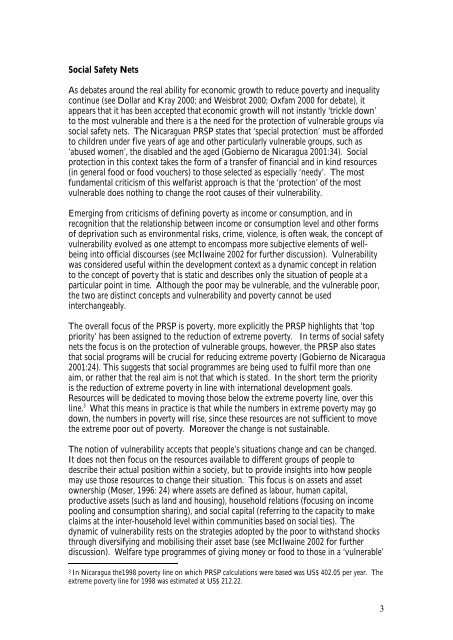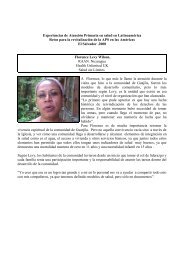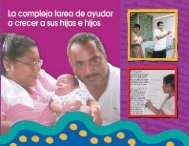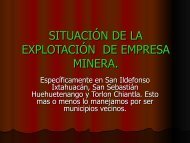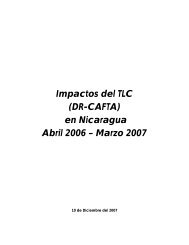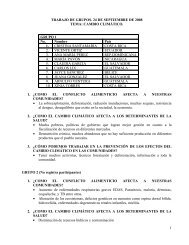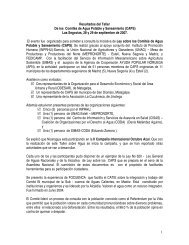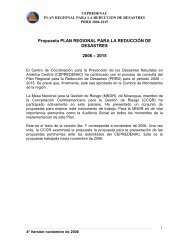A Gendered Analysis of the Social Protection Network in ... - CISAS
A Gendered Analysis of the Social Protection Network in ... - CISAS
A Gendered Analysis of the Social Protection Network in ... - CISAS
Create successful ePaper yourself
Turn your PDF publications into a flip-book with our unique Google optimized e-Paper software.
<strong>Social</strong> Safety Nets<br />
As debates around <strong>the</strong> real ability for economic growth to reduce poverty and <strong>in</strong>equality<br />
cont<strong>in</strong>ue (see Dollar and Kray 2000; and Weisbrot 2000; Oxfam 2000 for debate), it<br />
appears that it has been accepted that economic growth will not <strong>in</strong>stantly ‘trickle down’<br />
to <strong>the</strong> most vulnerable and <strong>the</strong>re is a <strong>the</strong> need for <strong>the</strong> protection <strong>of</strong> vulnerable groups via<br />
social safety nets. The Nicaraguan PRSP states that ‘special protection’ must be afforded<br />
to children under five years <strong>of</strong> age and o<strong>the</strong>r particularly vulnerable groups, such as<br />
‘abused women’, <strong>the</strong> disabled and <strong>the</strong> aged (Gobierno de Nicaragua 2001:34). <strong>Social</strong><br />
protection <strong>in</strong> this context takes <strong>the</strong> form <strong>of</strong> a transfer <strong>of</strong> f<strong>in</strong>ancial and <strong>in</strong> k<strong>in</strong>d resources<br />
(<strong>in</strong> general food or food vouchers) to those selected as especially ‘needy’. The most<br />
fundamental criticism <strong>of</strong> this welfarist approach is that <strong>the</strong> ‘protection’ <strong>of</strong> <strong>the</strong> most<br />
vulnerable does noth<strong>in</strong>g to change <strong>the</strong> root causes <strong>of</strong> <strong>the</strong>ir vulnerability.<br />
Emerg<strong>in</strong>g from criticisms <strong>of</strong> def<strong>in</strong><strong>in</strong>g poverty as <strong>in</strong>come or consumption, and <strong>in</strong><br />
recognition that <strong>the</strong> relationship between <strong>in</strong>come or consumption level and o<strong>the</strong>r forms<br />
<strong>of</strong> deprivation such as environmental risks, crime, violence, is <strong>of</strong>ten weak, <strong>the</strong> concept <strong>of</strong><br />
vulnerability evolved as one attempt to encompass more subjective elements <strong>of</strong> wellbe<strong>in</strong>g<br />
<strong>in</strong>to <strong>of</strong>ficial discourses (see McIlwa<strong>in</strong>e 2002 for fur<strong>the</strong>r discussion). Vulnerability<br />
was considered useful with<strong>in</strong> <strong>the</strong> development context as a dynamic concept <strong>in</strong> relation<br />
to <strong>the</strong> concept <strong>of</strong> poverty that is static and describes only <strong>the</strong> situation <strong>of</strong> people at a<br />
particular po<strong>in</strong>t <strong>in</strong> time. Although <strong>the</strong> poor may be vulnerable, and <strong>the</strong> vulnerable poor,<br />
<strong>the</strong> two are dist<strong>in</strong>ct concepts and vulnerability and poverty cannot be used<br />
<strong>in</strong>terchangeably.<br />
The overall focus <strong>of</strong> <strong>the</strong> PRSP is poverty, more explicitly <strong>the</strong> PRSP highlights that ‘top<br />
priority’ has been assigned to <strong>the</strong> reduction <strong>of</strong> extreme poverty. In terms <strong>of</strong> social safety<br />
nets <strong>the</strong> focus is on <strong>the</strong> protection <strong>of</strong> vulnerable groups, however, <strong>the</strong> PRSP also states<br />
that social programs will be crucial for reduc<strong>in</strong>g extreme poverty (Gobierno de Nicaragua<br />
2001:24). This suggests that social programmes are be<strong>in</strong>g used to fulfil more than one<br />
aim, or ra<strong>the</strong>r that <strong>the</strong> real aim is not that which is stated. In <strong>the</strong> short term <strong>the</strong> priority<br />
is <strong>the</strong> reduction <strong>of</strong> extreme poverty <strong>in</strong> l<strong>in</strong>e with <strong>in</strong>ternational development goals.<br />
Resources will be dedicated to mov<strong>in</strong>g those below <strong>the</strong> extreme poverty l<strong>in</strong>e, over this<br />
l<strong>in</strong>e. 3 What this means <strong>in</strong> practice is that while <strong>the</strong> numbers <strong>in</strong> extreme poverty may go<br />
down, <strong>the</strong> numbers <strong>in</strong> poverty will rise, s<strong>in</strong>ce <strong>the</strong>se resources are not sufficient to move<br />
<strong>the</strong> extreme poor out <strong>of</strong> poverty. Moreover <strong>the</strong> change is not susta<strong>in</strong>able.<br />
The notion <strong>of</strong> vulnerability accepts that people’s situations change and can be changed.<br />
It does not <strong>the</strong>n focus on <strong>the</strong> resources available to different groups <strong>of</strong> people to<br />
describe <strong>the</strong>ir actual position with<strong>in</strong> a society, but to provide <strong>in</strong>sights <strong>in</strong>to how people<br />
may use those resources to change <strong>the</strong>ir situation. This focus is on assets and asset<br />
ownership (Moser, 1996: 24) where assets are def<strong>in</strong>ed as labour, human capital,<br />
productive assets (such as land and hous<strong>in</strong>g), household relations (focus<strong>in</strong>g on <strong>in</strong>come<br />
pool<strong>in</strong>g and consumption shar<strong>in</strong>g), and social capital (referr<strong>in</strong>g to <strong>the</strong> capacity to make<br />
claims at <strong>the</strong> <strong>in</strong>ter-household level with<strong>in</strong> communities based on social ties). The<br />
dynamic <strong>of</strong> vulnerability rests on <strong>the</strong> strategies adopted by <strong>the</strong> poor to withstand shocks<br />
through diversify<strong>in</strong>g and mobilis<strong>in</strong>g <strong>the</strong>ir asset base (see McIlwa<strong>in</strong>e 2002 for fur<strong>the</strong>r<br />
discussion). Welfare type programmes <strong>of</strong> giv<strong>in</strong>g money or food to those <strong>in</strong> a ‘vulnerable’<br />
3 In Nicaragua <strong>the</strong>1998 poverty l<strong>in</strong>e on which PRSP calculations were based was US$ 402.05 per year. The<br />
extreme poverty l<strong>in</strong>e for 1998 was estimated at US$ 212.22.<br />
3


